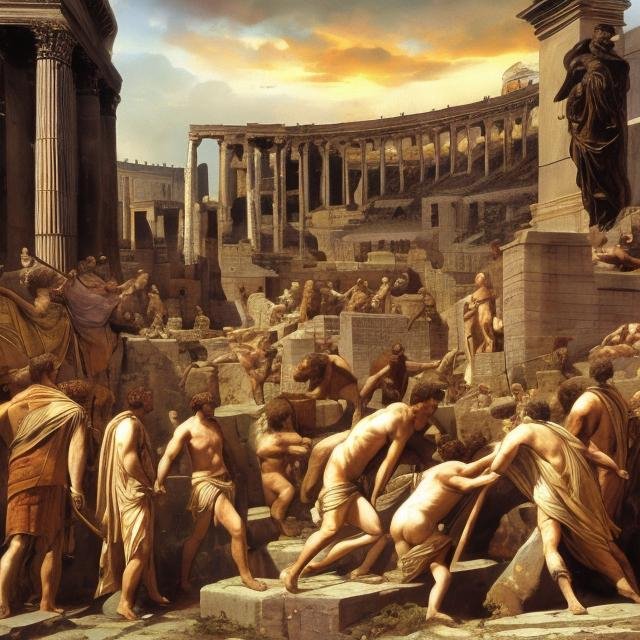The Rise and Fall of the Roman Empire

The Roman Empire is one of the most iconic and influential civilizations in human history. Its rise and fall have left an indelible mark on the world, shaping political, economic, social, and cultural developments for centuries to come. This essay delves into the intricate narrative of the Roman Empire, exploring its ascension from humble beginnings to the pinnacle of power, and its eventual descent into fragmentation and decline. With a rich tapestry of historical events, leaders, and societal transformations, the story of the Roman Empire provides invaluable insights into the complexities of empire-building, governance, and the enduring lessons of history.
I. The Foundation and Early Republic
1.1 Origins of Rome
The story of the Roman Empire begins with the legendary founding of Rome by Romulus and Remus in 753 BC. The mythical tale of the twins raised by a she-wolf captures the imagination, but Rome's true origins are rooted in a confluence of diverse peoples and cultures in the Italian Peninsula. The city's location on the Tiber River and the advantages it offered for trade and defense contributed to its early development.
1.2 The Roman Kingdom
After the founding of Rome, it gradually transitioned from a monarchy under Etruscan influence to a republic. The Roman Kingdom saw a series of kings and rulers, such as Tarquin the Proud, whose tyrannical rule contributed to the establishment of the Roman Republic around 509 BC.
1.3 The Roman Republic
The Roman Republic marked a significant shift in governance. It was characterized by a complex system of checks and balances, with a Senate and popular assemblies overseeing affairs. This period also saw the development of the Roman Legion, a disciplined and effective military force that would play a crucial role in the empire's expansion.
II. Expansion and Triumph
2.1 The Punic Wars
The Roman Republic's expansion was driven by military conquests. The Punic Wars, a series of conflicts with Carthage in the 3rd and 2nd centuries BC, were instrumental in expanding Roman influence across the Mediterranean. The charismatic leadership of figures like Scipio Africanus and the strategic brilliance of Rome's generals played a pivotal role in Rome's victory.
2.2 The Conquest of Greece
Rome's quest for dominance did not stop with Carthage. The conquest of Greece and the Hellenistic world had a profound impact on Roman culture, bringing art, philosophy, and other aspects of Greek civilization into Roman society.
2.3 Julius Caesar and the End of the Republic
The 1st century BC saw the rise of Gaius Julius Caesar, a military general who challenged the traditional power structures of the Republic. His assassination in 44 BC, followed by the rise of his grandnephew and adopted son, Octavian (later known as Augustus), marked the end of the Roman Republic and the beginning of the Roman Empire.
III. The Pax Romana
3.1 Augustus and the Principate
The reign of Augustus marked the establishment of the Principate, the early phase of the Roman Empire. Augustus shrewdly maintained the façade of the Republic while consolidating his personal power. This period, known as the Pax Romana, brought relative peace and stability to the empire, allowing for significant economic and cultural growth.
3.2 Expansion and Boundaries
During the Pax Romana, the empire reached its territorial zenith. The emperors who followed Augustus, such as Trajan and Hadrian, extended the empire to its greatest expanse, from Britain in the northwest to the Euphrates in the east. The construction of roads, like the famous Roman road network, facilitated trade and governance.
3.3 The Roman Economy
Rome's economic system relied on a combination of agriculture, trade, and slave labor. The exploitation of resources from conquered territories, such as grain from Egypt and gold from Hispania, fueled the empire's economic engine. This period also witnessed the emergence of a complex monetary system.
3.4 Society and Culture
Roman society was hierarchical, with a clear distinction between the aristocracy, the equestrian class, and the common people. Slavery was widespread, and Roman law codified the rights and responsibilities of free citizens. Roman culture thrived during this time, producing renowned works of art, literature, and architecture.
IV. Decline and Transformation
4.1 Crisis of the Third Century
The Pax Romana could not last forever, and the 3rd century AD brought a series of crises that severely tested the empire. Invasions by external forces, economic instability, and a string of short-lived and ineffective emperors created a turbulent period known as the Crisis of the Third Century.
4.2 Diocletian and the Tetrarchy
The emperor Diocletian initiated a series of reforms in an attempt to restore order and stability. One of his most significant innovations was the Tetrarchy, a system in which the empire was ruled by two Augusti and two Caesars, intended to facilitate smoother transitions of power.
4.3 Constantine the Great
Constantine the Great, one of the Caesars in the Tetrarchy, eventually emerged as the sole ruler of the Roman Empire. He is renowned for several key developments: the Edict of Milan, which granted religious tolerance to Christians; the founding of Constantinople (modern-day Istanbul) as the new capital of the Eastern Roman Empire; and his conversion to Christianity, a momentous event in Roman history.
4.4 Division of the Empire
After the death of Constantine, the empire was permanently divided into the Western Roman Empire and the Eastern Roman Empire (Byzantine Empire). The West faced numerous challenges, including repeated invasions by barbarian tribes, economic decline, and political instability.
V. The Fall of the Western Roman Empire
5.1 Barbarian Invasions
The 4th and 5th centuries witnessed a series of devastating invasions by various barbarian tribes, including the Visigoths, Vandals, and Huns. The sack of Rome by the Visigoths in 410 and the subsequent capture of Carthage by the Vandals in 439 were major blows to the Western Roman Empire.
5.2 Odoacer and the Fall of Romulus Augustulus
In 476, Odoacer, a Germanic chieftain, deposed the last Roman emperor, Romulus Augustulus, marking the traditional date for the fall of the Western Roman Empire. However, this event was the culmination of a long process of decline and transformation.
5.3 Legacy of the Western Roman Empire
The fall of the Western Roman Empire had profound and far-reaching consequences. It marked the end of classical antiquity and the beginning of the Middle Ages in Europe. The power vacuum left by Rome's collapse led to the emergence of new kingdoms and cultures across the continent.
VI. The Byzantine Empire
6.1 Survival in the East
While the Western Roman Empire crumbled, the Eastern Roman Empire, centered in Constantinople, managed to endure. The Byzantine Empire, as it is now known, continued to thrive, preserving many aspects of Roman culture and law.
6.2 Justinian I
Emperor Justinian I, who reigned from 527 to 565, sought to restore the Western Roman Empire by reconquering Italy and North Africa. His reign produced the famous Corpus Juris Civilis, a compilation of Roman laws, and marked a high point in Byzantine history.
6.3 Arab Conquests and Iconoclasm
The Byzantine Empire faced numerous challenges, including the Arab conquests in the 7th century and the Iconoclastic Controversy, which pitted iconoclasts against iconophiles. These events shaped the religious and cultural landscape of the Byzantine Empire.
VII. The End of the Byzantine Empire
7.1 The Seljuk Turks and the Crusades
The 11th century saw the rise of the Seljuk Turks, who threatened the Byzantine Empire. In response, the Byzantines sought aid from the West, leading to the First Crusade. While the Crusaders helped the Byzantines regain some territory, they also sowed distrust and division.
7.2 The Fourth Crusade
The Fourth Crusade, in particular, had disastrous consequences for the Byzantine Empire. Instead of assisting the Byzantines, the Crusaders sacked Constantinople in 1204, resulting in a period of Latin rule in the city and further weakening the Byzantine state.
7.3 Decline and the Ottoman Conquest
The Byzantine Empire continued to decline, facing threats from the Ottoman Turks. In 1453, Constantinople finally fell to the Ottomans under Mehmed the Conqueror, bringing an end to the Byzantine Empire.
VIII. Conclusion: Lessons from the Rise and Fall of Rome
The rise and fall of the Roman Empire serve as a powerful narrative that offers numerous lessons and insights for contemporary society. It is a testament to the complexity of governance, the impact of military prowess, the consequences of overreliance on slave labor, and the role of cultural exchange in shaping civilizations.
The legacy of Rome lives on in modern legal systems, architecture, art, and the languages of Europe. The Roman Republic's experiment with representative government and the lessons from the fall of the Western Roman Empire continue to inform discussions on governance, political stability, and the dangers of external and internal threats to a nation's well-being.
Understanding the rise and fall of the Roman Empire is not just a study of the past; it is a journey into the heart of human civilization. Rome's story is a vivid reminder that even the mightiest empires can crumble, and that the forces of history are vast and unpredictable. The lessons of Rome continue to echo through the ages, offering us a unique perspective on the rise and fall of civilizations and the enduring legacy of the past on the present.
Bibliography
[Please note that this essay does not include specific citations but draws from a wide range of historical sources, including books, articles, and academic papers, to provide an overview of the rise and fall of the Roman Empire. For more detailed and specific information, readers are encouraged to consult relevant historical sources and academic literature.]
What's Your Reaction?
















